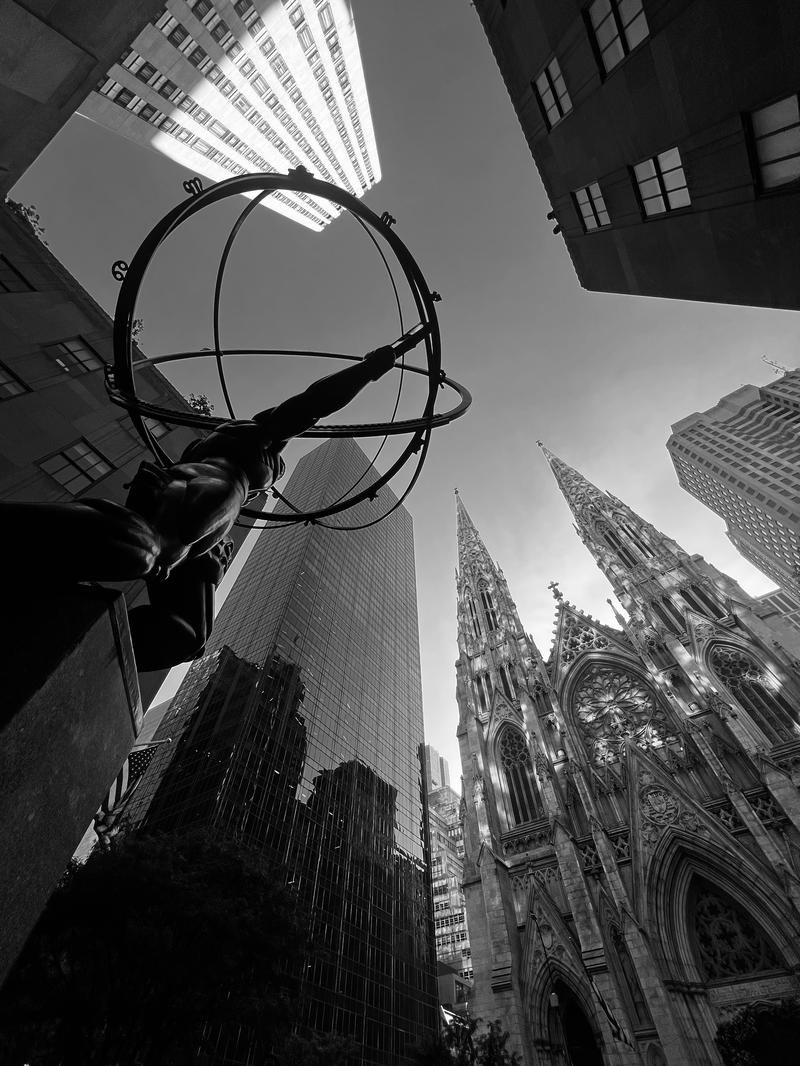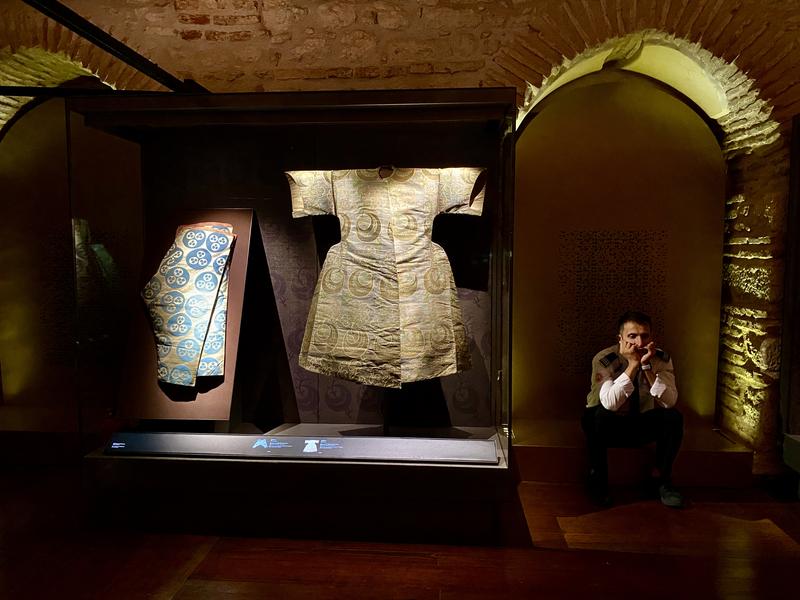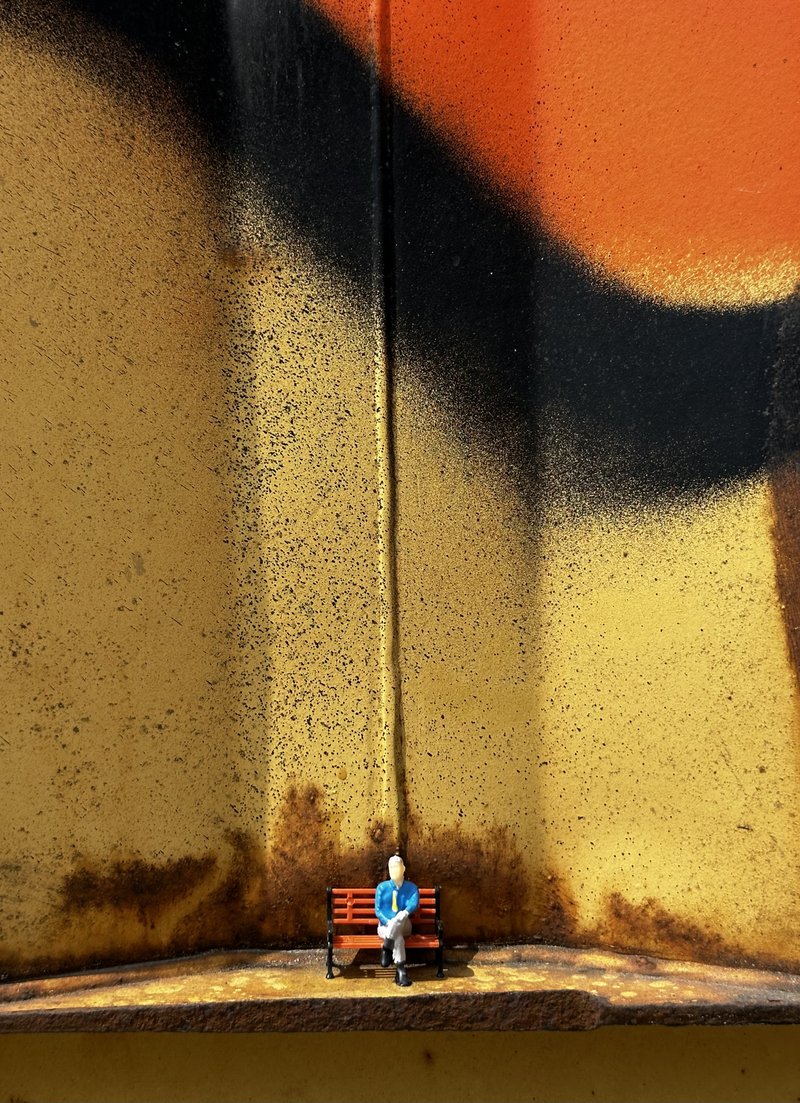Best Photo 2024 Contest Winners

( WNYC/Photoville )
Every year, The Brian Lehrer Show asks you to submit the best photo you took that is sitting on your phone – and every year, you deliver with some truly impressive snaps!
This year, you submitted over 700 photos! Our partners at Photoville, along with a special guest judge, photographer, filmmaker and Bronx-based photo-historian, co-founder of Seis del Sur, Edwin Pagán, picked out their favorites (check out their 'Top 50' gallery), and then Brian and the team joined in to help select three winners to present their photos on the air.
Brian speaks with Edwin and Laura Roumanos, executive director and co-founder of Photoville, about the three winning photos, which you can see below. Plus, this year's contest winners, Valerie Ramshur, Zai, and Taylor Mason talk about their winning photos.
This Year's Winners:

Weight of the World (Zai)

"just another day, another display case, and another hour to kill" (Valerie Ramshur)

Navy Yards figurine (Taylor Mason)
Title: Best Photo 2024 Contest Winners
[music]
Brian Lehrer: Brian Lehrer on WNYC. Each year, if you don't already know, the Brian Lehrer Show invites you to submit the best photo you took in this calendar year that is sitting on your phone. I have to say, when we first started doing this, phone cameras were meh. It was special to see how people were able to take great photos on these things called cell phones. Now the cameras on many of our phones have really improved, so it's special in a different way. The quality of so many of these pictures is so excellent, at least to my eye as a layperson.
As we've done for the past few years, we have some professional photographers here who have helped us browse through your submissions and pick out their favorites. As we discuss the three winning images, listeners, you can see them too. I mentioned it before the break, just go to brianlehrershow.org or wnyc.org and click on Brian Lehrer Show there. We do have brianlehrershow.org as a quick and easy pathway, and you'll be able to see the top three photos on our episode page for today that we'll be talking about.
Plus later today, this afternoon we'll post a gallery of the top 40 photos submitted this year according to our judges out of the 700 or so you sent in. Joining me now are Edward Pagán, a Bronx-based photographer, filmmaker, and photo historian. He's also the co-founder of Seis Del Sur, a photo collective of six photojournalism and documentary photography makers from the South Bronx. Laura Roumanos, executive director and co-founder of Photoville, the New York-based nonprofit that works to promote a wider understanding and increased access to the art of photography for all. Hi Edwin, welcome to WNYC. Laura, welcome back for another year of best photos sitting on your phone.
Edwin Pagan: Thanks for having me.
Laura Roumanos: Hi. Thanks [inaudible 00:02:09] [crosstalk]
Brian Lehrer: Before we bring on our winners, let's get to know a little bit more about each of you. Edwin, tell us about your work and how important your home borough of El Bronx is to your art.
Edwin Pagan: I'm happy to be joining you from the People's Republic of the South Bronx. I got introduced into photography when I was a young 10 years old at the Madison Square Boys & Girls Club. They basically showed me very on to give back to the community and to focus my lens on the community as a way of making sure that our narrative was told. The staff there was very, very instrumental and pointing me to a career that's actually led me to a full life and which extended later on into cinematography as a lifelong career.
Brian Lehrer: Laura, we've partnered with you and Photoville on this contest for several years now, just so our listeners know how much you've done for us on this. Why did you and the team at Photoville recommend Edwin to be the guest judge?
Laura Roumanos: Edwin has been a photographer for years that we've admired so much. This year we had the pleasure of actually exhibiting his work in Van Cortlandt Park in the Bronx as part of our annual festival. We just all fell in love with him and his spirit.
Edwin Pagan: Thank you.
Laura Roumanos: I think it's also people, as we can see here, everyone can take a good photo. But for us at Photoville, it's really important also about who these photographers are and it's about being human and wonderful and your ethics and I can keep going on. For us, it was a no-brainer when you all asked us, "Who should be the special judge this year?" We're like, "Edwin." We also wanted a New Yorker because as you can hear-- I've lived here for now nearly 20 years, but I was not born here. We wanted someone who was really a New Yorker.
Edwin Pagan: Thank you.
Brian Lehrer: Before we bring in our, our three winners, the two of you and the rest of the Photoville team looked through a lot of photos, like 700, as I said that our listeners submitted and we appreciate every listener who participates. But it's a ton of work for you. Thank you very much for doing that and taking the time and to you, Edwin, for joining this year and doing it with such care.
Now let's get to our winners who've been patiently standing by. First up is Zai. A one name wonder, just Zai. Listeners, again, just one last reminder. You can go to brianlehrershow.org, click on today's episode page and you'll see the winner's pictures. Zai, welcome to WNYC, and congratulations.
Zai: Thank you. Thank you for having me. I'm happy to be here.
Brian Lehrer: This photo is captioned, Weight of the World. You said it was the last photo you took in New York before you became a full-time nomad. Ha. Laura, I'm going to invite you for those listeners who can't click on the photo itself to try to put it into words a little bit and describe why you flagged it as a winner.
Laura Roumanos: I think we all agreed, Edwin, yourself, Brian, us. It's a black-and-white image of New York City. The light is incredible. We actually were all debating about the reflections on the cathedral, is it off the building? Then you have a statue with the atlas on top. Because that photo, you're looking from down, like looking up, it's that weight of the world. We were all even going, was it taken on a phone? That's where Brian, you mentioned phones are really amazing these days. It's also not just about the phone, but the photographer behind it and how they can actually use that tool to take that photo and to capture that moment. That's one of the reasons why we loved it.
Brian Lehrer: Zai, in a way, to my eye, this is a classic New York photo. Looking up at Fifth Avenue or on Fifth Avenue at St. Patrick's Cathedral and the statue of Atlas that's right there too, the building across the street from the cathedral. Somebody might think at first, well this could be on a postcard. I've seen this before. But you have it in black and white. As Laura said, it's really eerie. It's from the ground up, black and white beauty.
We also notice the tiny points of light being reflected. I guess it's from the sun bouncing off the windows of the building across the street from the cathedral and then shining on the cathedral, which is just so visually beautiful. What were you going for here? Shooting an area that's been shot a million times before.
Zai: To be honest, it was a holiday trip with my best friend and brother, Johnny Morales, and we were just getting coffee. His wife's favorite coffee shop is that Polo Pop up. I've always seen the Atlas in my walks of New York, but never in this moment did it strike me to photograph it in this light. I feel like as people, we take on the weight of others and our burdens end up bogging us down on a day-to-day basis.
That's how I felt that day. Although I was surrounded by loved ones. Honestly, my photography is just a reflection of where I currently stand mentally. Took my phone out because the only camera I had on my person at the time and hit the 0.5 setting and there we are. I exclusively shoot in black and white.
Brian Lehrer: I've never looked to see if my phone camera, my iPhone has a black and white option. You have that on your phone?
Zai: Yes. I do. I've set my phone up to where as soon as I open up my camera, it's in 0.5 and it's in black and white. I exclusively shoot black and white in my personal and professional work. For me, that's the number one setting I go to for any photo.
Brian Lehrer: Edwin, why do you flag this photo?
Edwin Pagan: It's amazing. I think as New Yorkers, we take the city for granted, and it's such an amazing metropolitan place in the world if you step out of it. We pass tableaus like this all the time, and we forget to look up because we're just running and gunning. I black and white-- [crosstalk]
Brian Lehrer: We make fun of people who do look up, like, "Oh, that's a tourist."
Edwin Pagan: Right. Rush them along because they've stopped to smell the roses. When I looked at this, it made me stop and smell the roses. The symmetry and everything that goes with it just balances out. It just reminds me of how for that moment, I was a tourist in my own town.
Brian Lehrer: Zai, congratulations. There's no cash prize here, but you get bragging rights as being a win of the Brian Lehrer Show's Best Photo on your phone contest for 2024. Thanks for coming on with us.
Zai: Thank you for having me. Real honored.
Brian Lehrer: Winner number two, Valerie Ramshur, whose photo is captioned, just another day, just another display case, and another hour to kill. Hi, Valerie. Welcome. Congratulations.
Valerie Ramshur: Hi. Thank you so much for having me. It's such an honor.
Brian Lehrer: Edwin, you picked this one as one of your favorites, so could you start by describing it to our listeners?
Edwin Pagan: There's an introspective moment there with the gentleman sitting below the lit arch, and then you have some traditional clothing just to the left of him in a case. It just made me look at it for quite a while. I was very happy that the system that we looked at the photographs also allowed us to enlarge it and look at it in detail. I just had to sit back the way you do in a museum, and you step back at the distance, at the right distance for the image and just take it in.
It just struck me and stayed with me. I think that's the thing with art sometimes. It's hard to sometimes describe it, but the emotional connection that it made with me, with the balance in this person there amongst their culture, really resonated with me. As a photojournalist, I do a lot of this myself, so I was really taken and connected with the image.
Brian Lehrer: I'm Glad you talked about enlarging it, because, Valerie, I have to admit that I was a little embarrassed by what I missed at first in this photo until Laura and her Photoville colleagues pointed it out to me. I thought, "Oh, it's a picture of a display case in a costume museum, so what?" I was looking at it on a small screen, and it took the judges on our team with a better eye for this, to make me look more closely and blow it up a little bit, and realized that this was about the museum worker sitting down in the right-hand corner of the frame, for whom the beauty of the museum display was just another day at the office for him.
Can you talk about if that's what drew you? It's an essential worker shot really within an art accompaniment on 90% of the frame.
Valerie Ramshur: Absolutely. I was just in Istanbul. I'm on sabbatical this year. I'm a professor. I was on Istanbul at the Topkapi Palace, looking at textiles and costumes. Like every other tourist, I was gasping and oohing and ahhing at these amazing Ottoman garments. Just like another tourist, I was trying to take in 500 years of culture in three hours. I looked over to the right, and this man just really spoke to me, this guard.
I felt a kindred spirit in that he was just exhausted, and the weight of history, of his own history was weighing on him as well and really exhausted. It was a photo of contrast for me. It was the excitement of discovery on one hand of the frame, and also the monotony of the familiarity on the right side of the frame. I felt it was just a wonderful moment to catch. I actually stood and stared at him longer than I stared at the garment.
Brian Lehrer: Once I knew to do that, then I was like, "Oh, yes, I get where this guy must be in his workday or the longer arc of his work life." Laura, you want to chime in on this image?
Laura Roumanos: I think we're all feeling like him right now at the end of the year.
[laughter]
Edwin Pagan: Absolutely.
Laura Roumanos: I feel like Edwin and Valerie really articulated what this image is. I agree, it's just that juxtaposition and the light, and it's just wonderful. I think we've all had those moments. This also just shows us-- Edwin explained this about Zai's, and also for this, it's like, I think sometimes we take for advantage a simple shot, but there's so much else going on around us that sometimes we just need to pay a little bit more attention. It's not just a beautiful garment in a display case. There's also something happening right next to it. This just goes to show, we should always just be looking out.
Brian Lehrer: We ignore the essential workers in our lives so much. It draws attention to that. Maybe a little less since the pandemic in 2020, but maybe even that has gone back to the way it used to be. Valerie Ramshur, congratulations. You win bragging rights on The Brian Lehrer Show best photo on your phone contest.
Valarie Ramshur: Thank you so much. It's been an honor, and happy holidays, everyone.
Brian Lehrer: Thank you. Now, our third winner, Taylor Mason, is here with us. Hey, Taylor. Congratulations.
Taylor Mason: Thanks so much, Brian. Longtime listener. It's an honor to be selected.
Brian Lehrer: The photo is called Navy Yard Figurine, and I'll describe it a little bit. Again, I have to admit, when I first looked at this one, I wasn't completely certain what I was looking at. It does turn out that it's a tiny figurine of a person sitting on a miniature bench perched on some brightly colored ledge with sweeping shades of orange, yellow, and black. It's very visually striking. How'd I do, Taylor? Want to tell us a little bit more about how you came upon the scene, or did you place that figurine there to snap the picture?
Taylor Mason: I did not place the figurine there. I'm a distance runner, and so I frequently run along Kent Avenue of the Navy Yards, and it's all these brightly colored shipping containers. I've probably ran past this place 60 times last year, and I just popped this out of the corner of my eye. It's tiny. The figurine is like the size of your thumb. I doubled back, pulled out my phone, took a picture, and forgot about it until I heard you were doing the contest again, and I went back to my pictures and found it.
Brian Lehrer: Laura and Edward, can you each weigh in a little bit on why this picture grabbed you? Even before you figure out that it's a figurine, the first thought that people might have is that it's just a regular person, because the figurine is small in the frame, so you have to look close to see that it's not a real person. Then it looks like there's this giant wall, maybe a metal wall with different colors on it, behind him. It's definitely a lesson in perspective and going, what's actually happening here? How big is that wall? Or how small is that person? Edwin, what do you want to say about it?
Edwin Pagan: When I first saw it, again, like you, I saw it small before I went around the second time and enlarged them because I just wanted to get first impressions just shooting through the set of all of them. Then I started blowing them up. When I came to this particular one, it was another one of those images that struck me because of the aspect ratio of the background to the figurine. You could imagine if that were a real-life size [unintelligible 00:16:20] is how big that metal plate would be and how big that weld would have to be that goes down the center.
One of the things also that caught me was the spray paint at the very top of the black and orange against the yellow. This was an image where as a designer, I also do graphic design also. and as a cinematographer, one of my favorite things is production design. if I was doing a scene where I wanted to evoke a scene of tranquility, although there is hard edges here and metal and rust contrast-wise and color-wise, everything seems to be separated perfectly.
You have him with a blue shirt against orange, which is opposite ends of the spectrum as well as then the orange from the rust which is now sitting on this yellow. It just has a perfect balance to it also with that streak in the top. You split things in half vertically. Then you have that color on the upper right-hand corner. It balances the image out, gives a little more of an anchor on the right side.
From the design point, I just really, really liked all the colors together and the composition of the frame. Being able to come upon something that small and insignificant that someone else thought was art and the way that they did this and capture it and also crop it the right way in the frame so that it speaks louder than just the individual component parts.
Brian Lehrer: Taylor Mason has photographed Navy Yard figurine. Congratulations. You win bragging rights as a Winner of the 2024 Brian Lehrer Show, best photo on your phone contest. Thanks.
Taylor Mason: Thanks, Brian. Appreciate it.
Brian Lehrer: As we wrap up, Edwin and Laura, I was wondering if you want to each shout out any projects or events or anything you're working on that you want to mention that the public might see or whatever. Edwin, you want to go first?
Edwin Pagan: Sure. We have a show currently at the Bronx Museum, History Museum in the Bronx of Seis Del Sur work. Also on 23rd, January, David Gonzalez, one of our members, is having an exhibit at the Fordham Gallery at Lincoln Center. Those are two things that you might want to look at and see if you're interested in attending and seeing some remarkable photography.
Brian Lehrer: That's great. Laura, Photoville stuff.
Laura Roumanos: David Gonzalez is amazing. Just a shout-out to all of you. Photoville, we're back next year for our 14th festival in New York City in Brooklyn, Bridge Park, and in NYC Parks across the five boroughs. We currently have a call for photographers or curators organizations to send in their ideas. If you go to photoville.nyc and if you have an idea for either a shipping container exhibition or an outdoor exhibition or a program, you can actually submit your idea for us.
We like to cast a wide net and let everyone have a chance. You never know because we actually, a quite a few exhibitions this year came through our proposal form. I would also say that as a nonprofit, we're always trying to raise money to support our educational and public art community efforts. [unintelligible 00:19:45] [crosstalk]
Edwin Pagan: That's right. As a participant of the 2024 cycle, I got to say it was an amazing experience. The care with which they printed my images and installed them in the location where they were showcased was amazing. Thanks to Photoville for having included me this cycle.
Laura Roumanos: Thank you.
Brian Lehrer: Edwin Pagan and Laura Roumanos, thank you so much for doing this work with us. Listeners, you can see the 40 out of the 700 or so that they picked as the top 40 at our website in a little while this afternoon, brianlehrershow.org. Laura and Edwin, happy holidays. Keep on shooting and let's do it again next year. Laura.
Laura Roumanos: Absolutely.
Edwin Pagan: Thank you, sir.
Laura Roumanos: Happy holidays. Thank you.
Edwin Pagan: Happy holidays. Thank you so much.
Brian Lehrer: That's The Brian Lehrer Show for today, produced by Mary Croke, Lisa Allison, Amina Srna, Carl Boisrond and Esperanza Rosenbaum. Our interns this term have been Andrés Pacheco-Girón and Olivia Green. Megan Ryan is the head of Live Radio. We had Juliana Fonda and Milton Ruiz at the audio controls. Stay tuned for All Of It.
[music]
Copyright © 2024 New York Public Radio. All rights reserved. Visit our website terms of use at www.wnyc.org for further information.
New York Public Radio transcripts are created on a rush deadline, often by contractors. This text may not be in its final form and may be updated or revised in the future. Accuracy and availability may vary. The authoritative record of New York Public Radio’s programming is the audio record.
